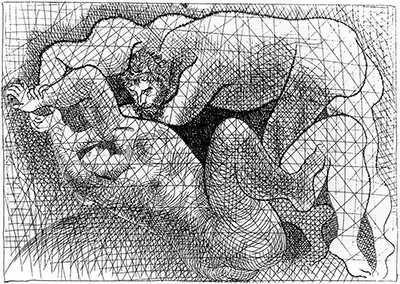Although Picasso has an extremely diverse portfolio, in particular we are going to discuss in more detail the painting of 'Man and Woman.' Painted by Pablo Picasso in 1927, it is very much influenced by the Neoclassicism style during the Neoclassicist and Surrealist Period. 'Man and Woman' is an etched painting and consists of a nude man and woman. This period of Neoclassicism and surrealism styles followed the upheaval of World War I. This particular style is evident in the work of many other European artists in the 1920s, including André Derain, Giorgio de Chirico, and the artists of the New Objectivity movement. Picasso's paintings and drawings from this period frequently recall the work of Ingres.
Between 1919 and 1929, most of Picassos paintings including that of 'Man and Woman' revived a somewhat more primitive and errotic style which is very evident in the 'Man and Woman.' His imagery potrayed througout his paintings during this period are very reflective of provocative sensualism and eroticism and this can also be seen in his other paintings such as 'The three dancers' of 1927, 'Figure' of 1927, 'Nude on a beach' of 1929 and 'Nude in an armchair' of 1929. And as with most artists, Picassoo's personal life played a key facto in his new style. The two most important factors were that of his new muse Marie-Therese Walter of whom he admired and was inspired by and also the growing closeness to the circle of Andre Breton who was an upcoming surrealist at that time.
Therefore while this painting gives us somewhat an insight into the personal life of Pablo Picasso at that time, we can certainly appreciate the feelings and emotions that he captualates in his paintings during this surrealistic period and especially that of 'Man and Woman.'

